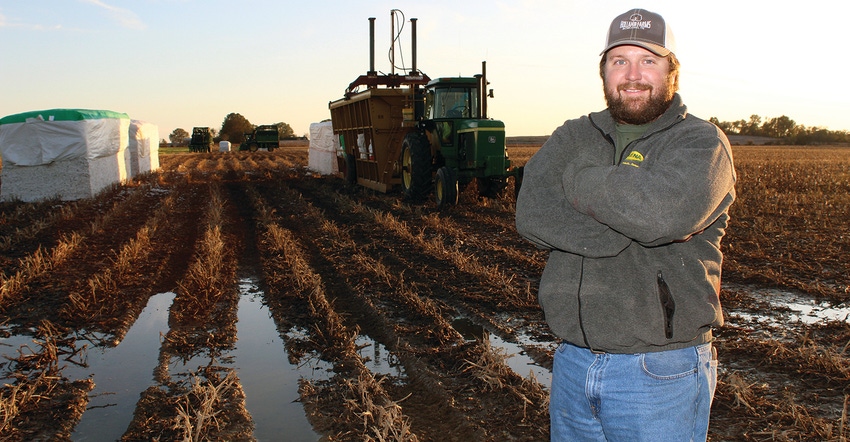
Tennessee cotton producer Clay Holland is trying to streamline labor by eliminating his old basket pickers and the labor headaches that came with them. He’s adding acres the newer equipment allows him to work.
He’s also improving his defoliation timing, plant growth efficiency and marketing.
Justifying the cost of a new on-board module harvester usually doesn’t pencil out with only 1,500 acres of cotton, but after inconsistent labor the last two years often left two basket pickers, two module builders, and two tractors idle on the turnrow, Holland evaluated labor and equipment options again.
“I’m aware of the recommended 2,000 acres of cotton it takes to justify this machine, but I found a used one at one-third the cost, so I got it,” Holland says. “The economics of getting the machine came together after I picked up enough acres of custom harvesting work at $100 an acre to more than help make the down payment and the first $47,000 payment due on April 1.”
Holland did not want to face another harvest with unmanageable labor issues and a labor-intensive equipment lineup. “I’ve already got one of my six-row basket pickers sold and am about to move the other one,” Holland says. “I’ll keep the four-row as backup in case I have another breakdown like I did two days after I started running the bailer picker and the turbo went out. That cost me $6,000.”
Now that he has the new harvester, he feels sure he can pick up more custom harvest cotton acreage to cover that repair bill. “More importantly, I won’t have to deal with that recurring labor problem during harvest,” Holland says. “Staging the rounds close to the road also eliminates the problem of module trucks not being able to get into muddy fields to pick up those traditional modules.”
Art of defoliation
Holland has been farming on his own since 2009 but under the tutelage of his father, Donny, since he was old enough to climb on a tractor. Together, they’ve learned that soil testing helps match varieties to the right ground.
“Daddy and I have learned these soils and know what varieties to place on each of them,” Holland says. “I started planting on April 29 this year when it was 56 degrees and misting rain. Daddy called me crazy, but I averaged 1,500 pounds on that one field and had 46 percent turnout on it at the gin.”
They learn from each other. Donny teaches from his decades of experience and Clay shares findings from research. “I’m a student of the crop, but daddy is a veteran.
“Two years back I had a sizeable number of acres defoliated when wet weather kept us out of the field for several days,” Holland says. “Regrowth had started and I was going to defoliate again, but he told me to just harvest it because if I defoliated it, some of that terminated regrowth would increase potential for leaf grade. He saved me some money.”
The Hollands know they do a better job today of managing cotton during the season with a plant growth regulator. “I spent a fortune two years ago trying to shrink some cotton I let get out of hand,” Holland says. “I told my wife I had really messed up because that cotton was so tall, I couldn’t see the rows. I had to get on an A/B line and just start defoliating. It averaged 1,300 pounds.”
Holland plans to be more proactive with his defoliation program next year. “I hope to do a better job of getting it prepped earlier so I can get it out and lower my risk from weather. I also had less leaf stick, for some reason, when I defoliated early,” Holland says. “I’ll also remember that the money I thought I was saving from not going with an additional insecticide application or another shot of defoliant ended up costing me yield.”
Holland hates to “cotton his ground to death” but with good soils, the low number of acres he farms, and the money he has in the new harvester, he put all of his eggs in the cotton basket this year and it paid off. “I planted some Deltapine 1725 B2XF that had a 46.2 percent turnout at the gin,” Holland says. “My neighbor didn’t believe me until I showed him the numbers — 1,494 pounds an acre on dryland.”
Marketing
Holland markets his own cotton, but admits he missed an opportunity by not selling equities when they were at 19 cents earlier this year. “I’m hoping a solution to the trade war will bring equities back to a dime,” Holland says. “The Market Facilitation Payment we got came at a good time, and I’ve heard the second tranche of payments has been approved. For me, the timing couldn’t be better as I face notes on my equipment.”
Thanks to the new cotton picker he now owns, the additional land he intends to rent, and the labor he will not need during next year’s harvest, Holland expects to see more profit in 2020.
About the Author(s)
You May Also Like




